Integrating digital solutions into the medical field revolutionizes how services are delivered and experienced. From virtual consultations to wearable devices, advancements in tech-driven healthcare transformed traditional care models into dynamic, real-time engagement. These shifts address longstanding barriers in communication and access, offering individuals the convenience of receiving essential services without unnecessary complications. As the demand for efficient and effective approaches grows, the role of remote technologies in bridging the gap between providers and those they serve has never been more important.
Here’s how tech is revolutionizing patient care in healthcare facilities:
Table of contents
- The Evolution of Technology in Medical Services
- The Rise of Remote Patient Monitoring (RPM)
- Improving Access to Medical Services with Tech-Driven Healthcare
- Streamlining Workflows Through Automation
- Addressing Data Security and Privacy Concerns
- Tailoring Services Through Advanced Analytics
- Empowering Individuals with Wearable Technology
- Encouraging Engagement Through Digital Platforms
- Revolutionizing Chronic Condition Management
The Evolution of Technology in Medical Services
Over the past decade, the medical field has experienced a remarkable shift, moving away from paper-based processes to the adoption of advanced digital systems. This transformation of tech-driven healthcare has led to faster, more efficient service delivery, particularly through the use of tools like electronic health records, telehealth platforms, and mobile applications. These innovations not only save time but also reduce the chances of communication breakdowns, which have traditionally caused delays in treatment.
For instance, telehealth platforms allow individuals to consult with their doctors from the comfort of their homes, eliminating the need for travel or waiting in long queues. Similarly, mobile applications have made it possible to schedule appointments, access lab results, and even receive reminders for medication. These advancements underscore the growing role of digital tools in improving accessibility and making medical services more efficient.
The Rise of Remote Patient Monitoring (RPM)
Remote patient monitoring (RPM) is a groundbreaking approach that enhances how individuals manage their health outside of traditional clinical settings. Through RPM, clinicians can track important health metrics, such as blood pressure, glucose levels, and oxygen saturation, in real-time, allowing them to intervene before minor issues escalate.
According to insights from a comprehensive guide to RPM, this technology is becoming essential to modern medical strategies, bridging the gap between individuals and their providers with precision and efficiency. Organizations like Prevounce, which offers RPM solutions, focus on creating easy-to-use and highly effective tools. These systems automate data collection, eliminating the need for manual tracking while providing practitioners with actionable insights. Also, RPM platforms often include education and support features that guide users in understanding their health metrics, encouraging informed decision-making.
Improving Access to Medical Services with Tech-Driven Healthcare
Technology has significantly enhanced access to services, especially for individuals in remote areas. Virtual consultations, telemedicine platforms, and online portals have bridged the geographical divide that once hindered timely medical attention. These solutions allow individuals to connect with professionals without needing to travel, making accessing essential services easier.
Beyond convenience, these tools provide flexibility for those with busy schedules or limited mobility. Online systems for scheduling, consultations, and follow-ups ensure timely support while reducing administrative challenges. With growing adoption, these solutions continue to make services more accessible for everyone, regardless of their location.
Streamlining Workflows Through Automation
Digital tools have simplified administrative tasks, allowing professionals to focus more on providing quality services. Automation in areas like scheduling, billing, and patient record management reduces the time spent on repetitive tasks, ensuring efficient workflows.
For example, automated reminders for appointments and medication adherence help users stay on track while reducing missed sessions. By integrating these systems into daily operations, practices can save time and resources, leading to improved overall efficiency. Automation benefits medical teams and enhances the experience for individuals seeking consistent and reliable care.
Addressing Data Security and Privacy Concerns
The increasing reliance on digital tools has raised concerns about data security and privacy. Protecting sensitive information is essential for maintaining trust between individuals and organizations. Advanced encryption methods, secure cloud storage, and compliance with privacy regulations are critical to ensuring that data remains protected.
Education is also key. Users must be aware of how their information is handled and the steps taken to safeguard their privacy. By adopting stringent security measures, digital platforms can provide peace of mind for both users and professionals.
Tailoring Services Through Advanced Analytics
Data analytics plays a pivotal role in creating personalized solutions. By analyzing patterns and trends, professionals can develop targeted strategies that address the unique needs of each individual. Predictive analytics, for example, allows for early detection of potential health risks, enabling proactive measures to prevent complications.
These insights also improve decision-making, helping teams allocate resources more effectively. Advanced analytics ensures a more precise and tailored approach, enhancing outcomes and satisfaction for everyone involved.
Empowering Individuals with Wearable Technology
Wearable devices like fitness trackers and smartwatches have become essential tools for monitoring daily activity and overall well-being. These devices collect data on heart rate, sleep patterns, and physical activity, providing valuable insights for users and professionals.
The convenience of wearables lies in their ability to provide real-time feedback, helping users make informed lifestyle choices. Paired with remote monitoring platforms, they form a comprehensive system that supports ongoing health management. The growing adoption of wearable technology reflects its significant impact on modern care strategies.
Encouraging Engagement Through Digital Platforms
Digital engagement tools, including mobile apps and online portals, encourage individuals to take an active role in their well-being. These platforms provide access to educational resources, progress tracking, and professional communication, fostering collaboration and empowerment.
Individuals engaged in their own care are more likely to adhere to treatment plans and achieve better outcomes. Digital tools enhance communication and provide a sense of ownership and accountability, which is crucial for long-term success.
Revolutionizing Chronic Condition Management
Technology has profoundly impacted the management of long-term conditions like diabetes, hypertension, and respiratory disorders. Tools such as RPM systems, wearable devices, and telehealth platforms allow for continuous oversight and timely intervention.
These innovations reduce the burden of frequent office visits while ensuring that individuals receive the support they need. By providing real-time data and actionable insights, digital solutions enhance the quality and consistency of care for those with ongoing medical needs.
Integrating technology into the medical field bridges gaps that once hindered communication and access. These advancements in tech-driven healthcare, from remote monitoring to wearable devices, are reshaping how services are delivered and experienced. Tools like RPM provide opportunities for real-time oversight and personalized support, improving outcomes for individuals and professionals alike. By adopting and refining these digital solutions, we can look forward to a more efficient and connected system that benefits everyone involved.










